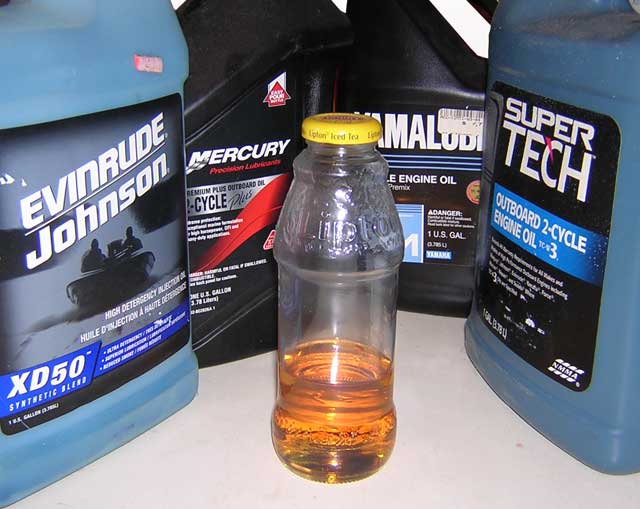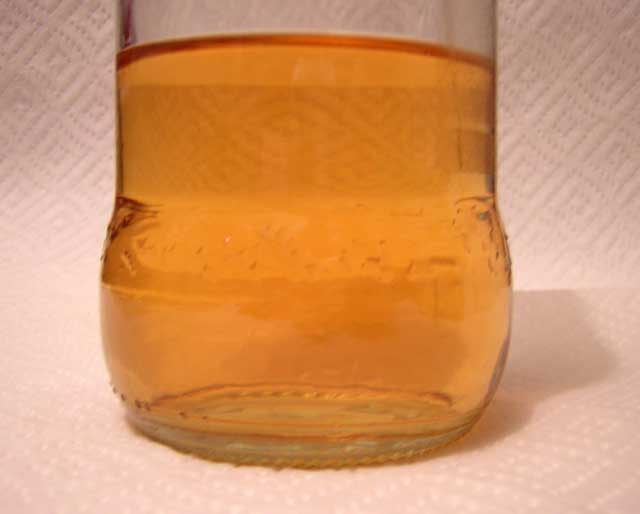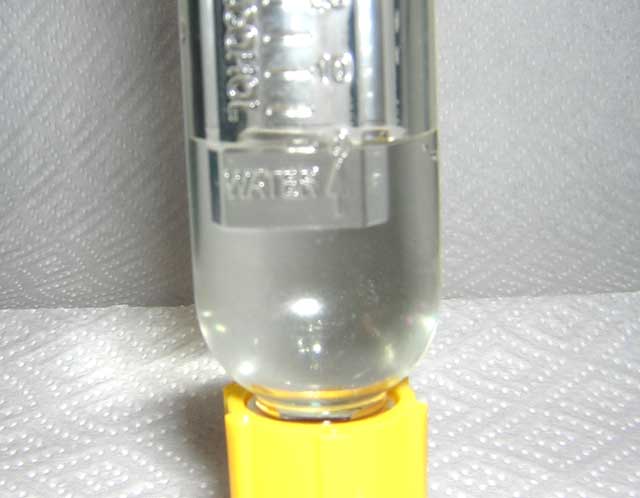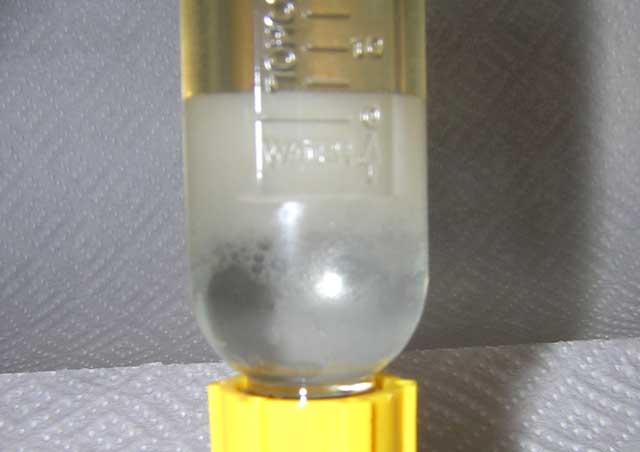Ethanol Fuel Testing
Determining ethanol content in blended gasoline fuels
by James W. Hebert
This article presents a simple and inexpensive test procedure for determining the alcohol and water content of blended gasoline fuels.
Blended Gasoline
More and more gasolines sold for automotive and marine use are blended fuels consisting of gasoline and ethanol in a solution. In most cases the ethanol content of the fuel is less than ten-percent. In some states there is no labeling requirement, so consumers have no way to determine if the fuel they are purchasing contains any ethanol at all. Generally, in all states fuels which contain greater than ten-percent ethanol have to be labeled at the retailer's pump. Because many boaters use older engines which were not designed to run on blended fuels, they may wish to avoid any gasoline blends with ethanol.
How much water a fuel can hold in solution before phase separaton occurs depends on its blend. Gasoline blended with ethanol can hold more water in solution than pure gasoline. Gasohol, or E10, or gasoline and ethanol in a 9:1 blend, can hold about 0.5-percent water in solution. Any more water content and the water will separate. This principle forms the basis for a simple test procedure.
Test Procedure
A simple test can determine the ethanol or water content of a fuel sample. All that is needed is a sample of the fuel, some water, and a test tube or graduated cylinder. The procedure is as follows:
- Obtain a sample of the fuel to be tested
- Fill a test tube or graduated cylinder with water in a volume of 25-percent of the total volume
- Fill the remaining 75-percent volume of the test tube or cylinder with the sample fuel
- Install a rubber stopper and shake the test tube or cylinder to thoroughly mix the test sample with the water.
- Place the test tube or cylinder in an upright and stable position, and allow the solution to separate into two phases.
- If the test sample of fuel contained any water or alcohol, it will have come out of solution with the gasoline and into solution with the water. Observe the position of the phase boundary and deduce the change in volume according to the formula below, or
- If using a calibrated cylinder, read the alcohol content of the original sample from the graduations on the cylinder.
In aircraft use of blended fuels containing gasoline and ethanol is highly discouraged by the Federal Aviation Administration (FAA). Because of this, a private recreational pilots association, the Experimental Aircraft Association (EAA), has produced a fuel test kit for checking auto gasoline used in aircraft for ethanol content. They are pleased to sell the kit to non-members. I ordered a fuel test kit ($15) from EAA by telephone and promptly received it by mail a few days later. Their tester is shown in the photographs below.
 |
Gas Sample
This small sample of gas had unknown ethanol and water content both when purchased at the retailer's pump and when drawn from my boat's tank. A 70-percent mixture of isopropyl alcohol and water ("rubbing alcohol") was added to it in approximately a 1:4 ratio by volume for the purpose of demonstration.
Photo Credit: James W. Hebert |
 |
Gas Sample Close Up
There is no phase boundary present in this sample. All of the water and alcohol are in solution with the gasoline.
Photo Credit: James W. Hebert |
 |
Tester
The first step in testing is to add pure water to the test cylinder until filled to the calibration mark "WATER" as seen here. This is about 25-percent of the total volume of the test tube.
Photo Credit: James W. Hebert |
After water is added to the test cylinder, the gasoline sample is poured in on top of the water until the cylinder volume is full (the GASOLINE mark is reached on the EAA test kit). The two liquids remain in phase separation from each other.
Next, the test cylinder is agitated to mix the two liquids, then allowed to settle. If there were ethanol or water in the gasoline, it will tend to leave that solution and join the water. The relative volumes of the fuel and the water will change.
 |
Test Results
The EAA test cylinder has graduations which have been pre-computed to show the percentage of the fuel which contained water or alcohol. In this test the fuel appears to have had about four-percent alcohol content. Note the cloudy material which has separated from the fuel and is in the water-alcohol. This is the "milky white gunk" often reported seen retained in fuel filters.
Photo Credit: James W. Hebert |
The ethanol content of the fuel can be deduced by the change in volume of the two liquids after the phase separation has been allowed to be restored. After the test, the small volume of fuel and water is discarded.
Test Theory
The fuel sample is mixed with a volume of water that is large enough to ensure that there will be too much water to go into solution with the gasoline. The test procedure assumes that in the presence of all this extra water any alcohol and water already in solution with the gasoline will leave. By driving all the water and alcohol out of the gasoline and into the other solution, the composition of the fuel sample is revealed. The change in volume can be assessed according to this relationship:
Let W be the volume of the water to be added
to the sample relative to the total volume
in the test tube. This is usually chosen to
be much more than the 0.5-percent maximum
that ethanol can hold in solution. In our
example we will use 25-percent volume for
water in the test tube. This will be the initial
volume of the lower phase in the test tube.
Let F be the volume of the fuel sample,
which is always the total volume minus the water;
in our case 75-percent of the total volume.
This will be the initial volume of the upper
phase in the test tube.
Let D be the increase in the volume of lower
phase in the test tube relative to the total
volume which occurs when the water and fuel
are fully mixed and allowed to separate
into two phases.
If we have a 100-ml cylinder, we can let
F = 75 ml
W = 25 ml
After mixing there will be an increase in volume
in the lower phase by an amount D (ml), which is
the amount of water and alcohol which came out
of the sample and went into solution with the water.
The original volume of the sample was F, and the
new volume of the sample is less, or F-D,
which is pure gasoline portion.
The volume change, D, was the water or alcohol
driven out of solution. The percentage of the
sample which was either water or alcohol is therefore
Percent = D/F X 100
For example, if the phase boundary moves up 5-ml,
then the percentage of the fuel that was water
and alcohol was
Percent = 5/75 X 100
= 6.7 percent
The above probably won't pass muster if carefully examined by a Ph.D in Chemical Engineering. When chemical reagents of a certain volume mix together the resulting solution does not always have a volume equal to the sum of the two reagents' volumes. Water and alcohol are a good example. About 4-percent of the total volume is lost when they are mixed. But setting aside little details like that, the analysis above ought to give a boater a reasonable estimate of the ethanol content of his fuel to within a percentage point or two. If a more accurate rule for gauging ethanol content from relative volume of the two phases is developed, I will update the article to include it. As for the EAA tester, I assume they already did their homework and got the calibration correct on their device.
DISCLAIMER: This information is believed to be accurate but there is no
guarantee. We do our best!
The page has been accessed times.
Copyright © 2007 by James W. Hebert. Unauthorized reproduction prohibited!
This is a verified HTML 4.0 document served to you from continuousWave
URI: http://continuouswave.com
Last modified:
Author:James W. Hebert
This article first appeared November 18, 2007.



